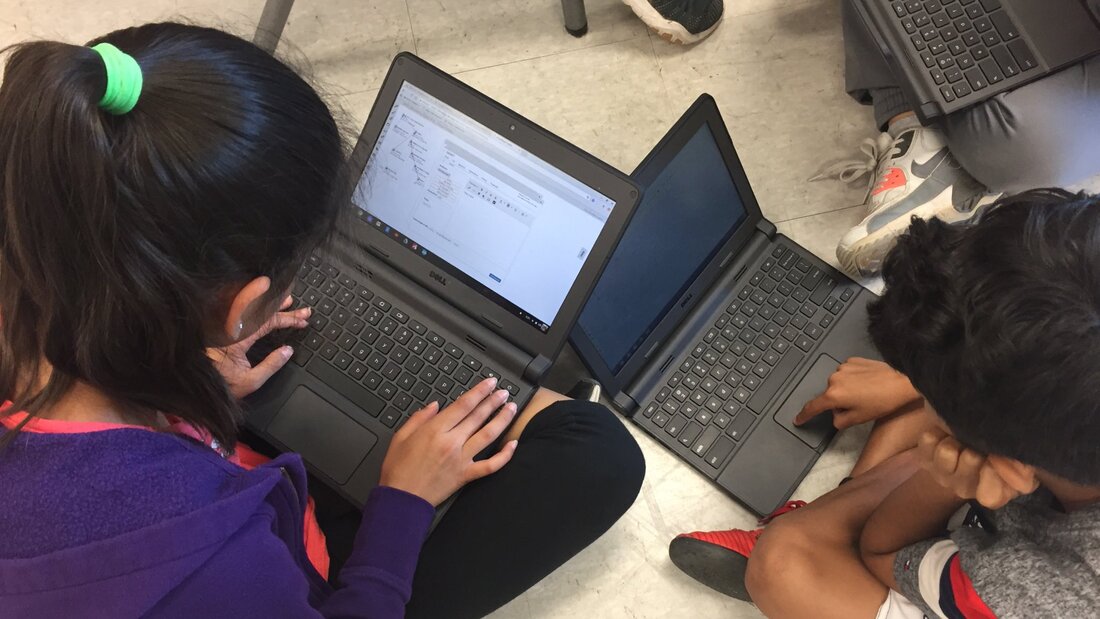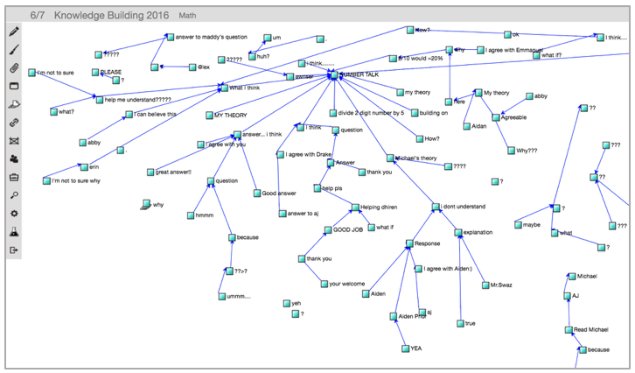'The heart of CSILE/Knowledge Forum is a multimedia community knowledge space. In the form of notes, participants contribute theories, working models, plans, evidence, reference material, and so forth to this shared space. The software provides knowledge building supports both in the creation of these notes and in the ways they are displayed, linked, and made objects of further work. Revisions, elaborations, and reorganizations over time provide a record of group advances, like the accumulation of research advances in a scholarly discipline'. (https://www.ikit.org/fulltext/CSILE_KF.pdf)
Knowledge Forum is intended to be an educational version of science where science is understood to be a global networked shared inquiry or dialogue. Students work together in small groups to come up with questions and then inquire into these together by making hypotheses and supporting these with arguments and evidence. Although there are many face to face discussions the claims and evidence for them is uploaded in the form of 'notes' in the shared forum space.
Example of a Knowledge Forum map[1]
In building this shared knowledge map students are helped by guides or 'scaffolds' - the row of buttons on the left hand side of the screen. These can be customised depending on the topic and the age of the kids but are usually based around theories, evidence to support the theories and, of course, challenges with counter-evidence. What has always excited me about Knowledge Forum though is one special scaffold: the 'rise above' scaffold or button. Marlene writes about this button:
' ...the most constructive way of dealing with divergent or opposing ideas is not to decide on a winner or a compromise position but rather to create a new idea that preserves the value of the competing ideas while “rising above” their incompatibilities. In the simplest cases a rise-above may be simply a summary or distillation; in the most compelling cases, the rise-above presents a new idea that all the participants can recognize as an advance over their previous ideas.'
One aspect of rise above move is encapsulating an area of dialogue. Other contributions can be dragged and dropped into the rise above button such that it is seen to represent a whole network of nodes. This is useful to simplify an over complex map. But, much more than this, the 'rise above' button is used to express a new insight that integrates the debate so far by making sense of it.
CSILE/Knowledge Forum has been around for over 30 years and if you search you can find many examples of maps and 'rise above' moves online. The examples seem to be mostly about science topics with children exploring questions that they themselves ask such as 'why does it rain?' or 'why are leaves green?'. But this approach is not limited to stem areas. Recently in Hong Kong a class of high school students of 15 to 16 years old explored the question: 'what is design?'. This inquiry included dialogue, conducted within in the Knowledge Forum system, with design professionals and academics while these were physically located outside of the classroom. The students began focussing on the idea that design is about 'solving problems' but increasingly explored the overlap between design and self-expression through art. Their final 'rise-above' move was to recognise that good design combined both utilitarian problem solving and a more artistic expression of a point of view on reality realised in each of the little choices that were made in process of design itself.
Is 'rise above' pushed or pulled?
The idea that learning involves a 'rise above' move is not new. Piaget wrote about how learning involves the development of schemas or 'cognitive structures'. When the data do not fit with the existing schema this leads, he wrote, to 'disequilibrium' which is uncomfortable forcing a new more adequate schema to emerge. He called this process 'accommodation'. The problem with this account from Piaget is that he implies that 'rise above' is not creative but is necessary, pushed from below by logical contradiction. But his theory has not been well supported by the empirical evidence. We are all, apparently, quite capable of living with contradictions in different areas of our experience. The formation of more adequate schema does not happen automatically. It can happen, but only when these different areas are brought into conscious dialogue with each other. Our capacity to rise above is not so much pushed from below by unconscious brain mechanisms as pulled from above by the promise of a new, more comprehensive vision that emerges only within dialogue.
So how does this work? In every dialogue there is not just my voice and your voice but there is also a third voice, the 'witness' which is the emergent perspective arising out of the dialogue as whole. When we 'rise above' we leave our initial position behind in order to inhabit a new more collective and more comprehensive perspective. Being able to rise above in this way is not just about logic it is also requires what could be called a virtue. To be able to rise above you have first to be able to listen to the voice of truth, or at least the voice of a perspective that is more true in the context.
When I think of my own experiences of learning it is rise-above moments that come to mind. Moments when I was led to understand something after engaging in a shared enquiry with other points of view that challenged my original ideas and made me realise that I had been partial and limited and that there is a different way of seeing that makes much better sense of things. Understanding how the rise above move happens can give us insight into the essence of learning and so enable us to design educational encounters that can better support learning.
Rise above and science
Currently as I write, a great deal of collective learning is going on in response to the challenge of a global pandemic. This is a global shared inquiry mediated by the Internet. At the very end of last year the WHO spotted a new virus in Wuhan, China; by the end of January this year Chinese doctors had sequenced the whole genome of COVID19 and shared it on the Internet, by 16th March the first dose of a possible vaccine was developed and administered in the USA. Information and theories about how best to respond to the pandemic are being shared around the world. Most agree that we need to trust the science, including the science of crowd behaviour, but it is clear that science here is complex and uncertain, involving a debate between experts who have a range of views. What makes this debate 'science' is not just the reference to empirical evidence but also the motivation of the participants. What defines science is never a fixed method, after all the appropriateness of any method also always needs to be argued for, but it is much more an attitude - an orientation towards the truth which can best be seen when people change their minds and rise above egotism or tribalism to see the things in a new way, a way that better fits the arguments and the evidence.
As C. S. Pierce argued over 100 years ago, scientific truth is not a simple idea - it is an ideal - an ideal of the future - the ideal of what scientists will agree on after all the relevant research has been done and every possible avenue gone down. It is this future that calls to us when we find ourselves able to rise above.
Dialogic education with networked technology of the kind that is exemplified by Knowledge Forum® is not always the most efficient way to learn curriculum content. It can certainly do that but much more than that, it is a good way to teach children to have a passion for the truth. It is relevant that this essence of learning is not a brain mechanism or even a word, but a button on a screen enabling the creation of a new node in a shared network. Learning is not individual but collective, always indissolubly both human and machine. I wager that the perspective of the future will reveal that children learning how to use the rise above button is the kind of education that we need as a species if we are to survive and thrive in this complex, interconnected and highly unpredictable universe.
Some possible further reading
Chan, C., Tong, Y., & van Aalst, J. C. W. (2019). Progressive dialogue in computer-supported collaborative knowledge Building. In Mercer, N., Wegerif, R and Major, L (Eds) The Routledge international handbook on research on dialogic education (pp. 469-484). Routledge.
Kemple, B. (2019) C. S. Peirce on Science and Belief
https://epochemagazine.org/c-s-peirce-on-science-and-belief-9e1283348c2
Wegerif, R. (2019). Towards a dialogic theory of education for the Internet Age. In Mercer, N., Wegerif, R and Major, L (Eds) The Routledge International Handbook of Research on Dialogic Education, (pp 14-26) Routledge
(PDF online)
[1] Figure from Milinovich, S and Ma, L (2018) Promoting Student Engagement and Well-being through Community Knowledge Advancement. Rethinking Learning in the Digital Age: Making the Learning Sciences Count, 13th International Conference of the Learning Sciences (ICLS)
https://www.researchgate.net/publication/329840876_Promoting_Student_Engagement_and_Well-being_through_Community_Knowledge_Advancement
Perez Linares, J. and Wegerif, R. (2019) Dialogar para pensar y aprender juntos en el aula. Mexico city: Porrua


 RSS Feed
RSS Feed